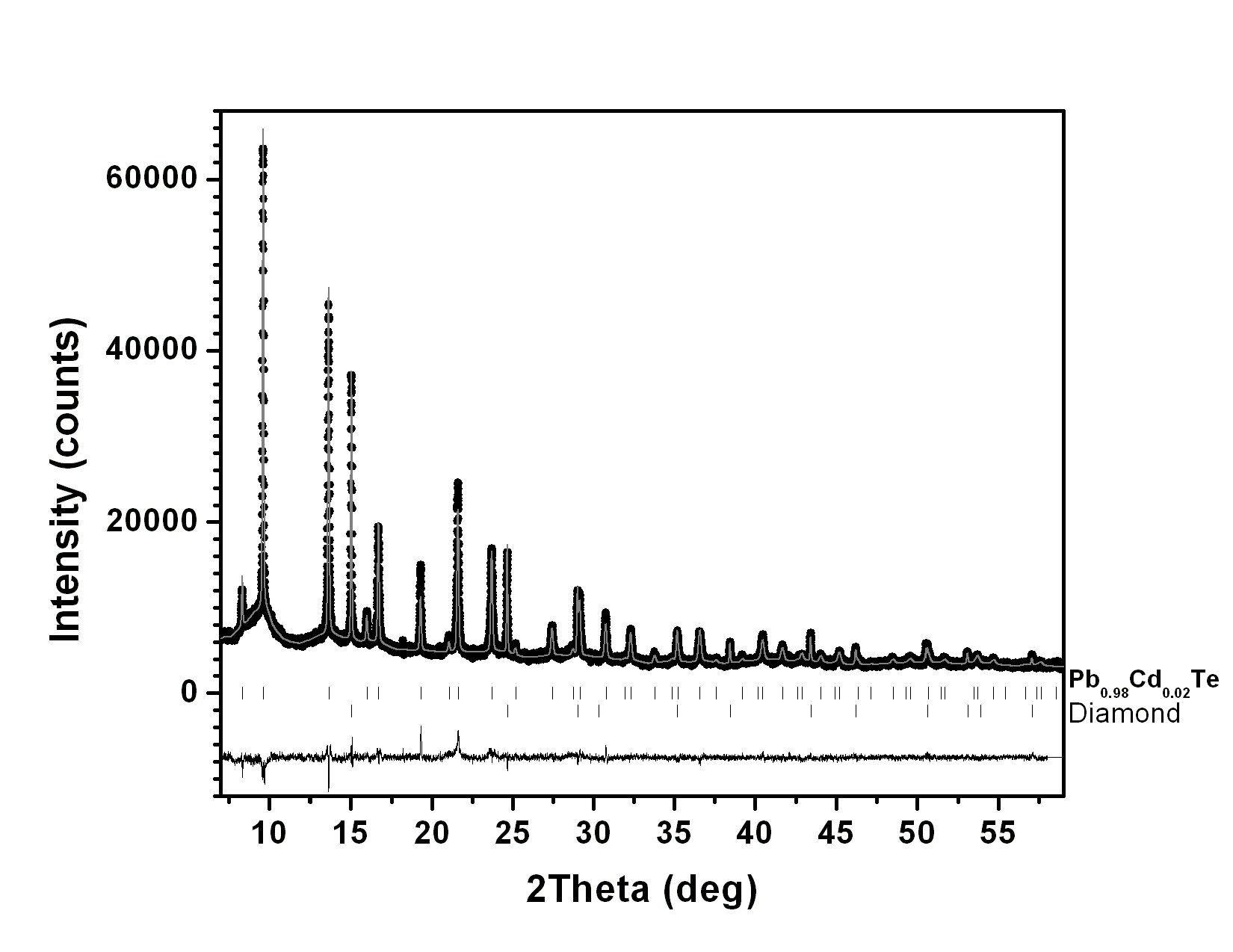| Search for content and authors |
Low-temperature expansion of metastable Pb1-xCdxTe solid solution |
| Roman Minikayev 1, Elzbieta Dynowska 1, Tomasz Story 1, Andrzej Szczerbakow 1, Anthony Bell 2, Dmytro M. Trots 3, Wojciech Szuszkiewicz 1 |
|
1. Polish Academy of Sciences, Institute of Physics, al. Lotników 32/46, Warszawa 02-668, Poland |
| Abstract |
The PbTe-rich PbTe-CdTe system, containing a lot of CdTe precipitates, may be considered as a composite matrix perfectly matching principal properties required for future thermoelectric applications. However, it is difficult to obtain a uniform material of this kind. So far, in the case of bulk crystals grown by the Bridgman technique or by rapid quenching and annealing method only polycrystalline samples were obtained for the CdTe molar fraction x > 0.03. For quenched Pb1-xCdxTe solid solutions, the limited information about the phase diagram and on the solubility limit of CdTe in PbTe were obtained long time ago [1-4]. On the basis of these data the thermodynamic behaviour of the Cd-Pb-Te system was also recently analyzed [5]. The successful growth of single bulk Pb1-xCdxTe crystals (with x ≤ 0.11) at the Institute of Physics of the Polish Academy of Sciences in Warsaw opened new research opportunities, as was reported earlier [6, 7]. These crystals were grown by self-selecting vapor transport method [8]. In particular, an access to new materials of high-quality made it possible to investigate the relevant part of the phase diagram in detail. The results of above mentioned investigations demonstrated the necessity of important modifications of this diagram. The selected results have been shown in recent publications [7, 9] and confirmed in part by independent studies [10, 11]. .
Figure 1. The capillary inside the cryostat prepared for low-temperature X-ray diffraction measurements (the upper part of the cryostat was removed). In this work we would like to report the preliminary results of X-ray powder diffraction studies performed on a set of Pb1-xCdxTe solid solutions at low temperatures (15K ≤ T ≤ 300K). In–situ low temperature X-ray diffraction measurements were performed at the B2 (Hasylab/DESY), using the Debye–Scherrer geometry. For that purpose the samples were prepared as a mixture of powdered Pb1-xCdxTe crystals and fine diamond powder, and placed in a thin-wall quartz capillary. During the measurements the capillary rotates inside the cryostat (Fig. 1). The analysis of the results accomplished with the Rietveld refinement (an example of the fit is shown in Fig. 2) demonstrated a monotonous evolution of the lattice parameter with temperature (see Fig. 3). The expansion of investigated samples at studied temperature region and the compatibility of obtained results with previously reported data for CdTe [12,13] and PbTe [14, 15] will be shown and discussed. 
Figure 2. Rietveld refinement for Pb1-xCdxTe (x = 0.02). The observed data are indicated by dots and the calculated ones by the solid line. The short vertical lines mark the positions of Bragg reflections, whereas the lower curve shows the difference between the observed and calculated powder diffraction patterns.
Figure 3. Temperature dependencies of lattice-parameters of PbTe (○) and Pb0.98Cd0.02Te (▲) in the low-temperature range. The research leading to these results has been partially supported by the European Community’s Seventh Framework Programme (FP7/2007-2013) under grant agreement no. 226716, by the European Union within the European Regional Development Fund, through grant Innovative Economy (POIG.01.01.02-00-108/09), and by the Ministry of Science and Higher Education (Poland) grant DESY/68/2007. References: [1] A.J. Rosenberg, R. Gierson, J.C. Woolley, and P.M. Nikolic, Trans. A.I.M.E. 230, 342 (1964). [2] P.M. Nikolic, Brit. J. Appl. Phys. 17, 341 (1966). [3] A.J. Crocker, J. Mater. Sci. 3, 534 (1968). [4] V. Leute and R. Schmidt, Z. Phys. Chem. 172, 81 (1991). [5] Y. Liu, L. Zhang, and D. Yu, J. Electron. Mater. 38, 2033 (2009). [6] M. Szot, A. Szczerbakow, K. Dybko, L. Kowalczyk, E. Smajek, V. Domukhovski, E. Łusakowska, P. Dziawa, A,. Mycielski, T. Story, M. Bukała, M. Galicka, P. Sankowski, R. Buczko, and P. Kacman, Acta Phys. Pol. A 116, 959 (2009). [7] R. Minikayev, E. Dynowska, P. Dziawa, E. Kamińska, A. Szczerbakow, D. Trots, and W. Szuszkiewicz, Synchr. Rad. Nat. Sci. 8, 83 (2009). [8] A. Szczerbakow and K. Durose, Prog. Cryst. Growth Character. Mater. 51, 81 (2005). [9] R. Minikayev, E. Dynowska, E. Kamińska, A. Szczerbakow, D. Trots, T. Story, and W. Szuszkiewicz, Acta Phys. Pol. A 119, 699 (2011). [10] M.K. Sharon, Zh. Neorgan. Khim. 55, 1190 (2010) (in Russian); J. Inorg. Chem. 55, 1119 (2010). [11] K. Ahn, M-.K. Han, J. He, J. Androulakis, S. Ballikaza, C. Uher, V.P. Dravid, and M.G. Kanatzidis, J. Am. Chem. Soc. 132, 5227 (2010). [12] S.I. Novikova, Fiz. Tverd. Tela 2, 2341 (1960) (in Russian); Sov. Phys. Solid State 2, 2087 (1961). [13] T.F. Smith and G.K. White, J. Phys. C 8, 2031 (1975). [14] S.I. Novikova and N.Kh. Abrikosov, Fiz. Tverd. Tela 5, 1913 (1963) (in Russian); Sov. Phys. Solid State 5, 1397 (1964). [15] B. Houston, R.E. Strakna, and H.S. Belson, J. Appl. Phys. 39, 3913 (1968). |
| Legal notice |
|
| Related papers |
Presentation: Poster at IX Krajowe Sympozjum Użytkowników Promieniowania Synchrotronowego, by Wojciech SzuszkiewiczSee On-line Journal of IX Krajowe Sympozjum Użytkowników Promieniowania Synchrotronowego Submitted: 2011-06-14 12:17 Revised: 2011-09-09 12:58 |